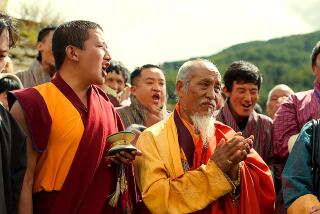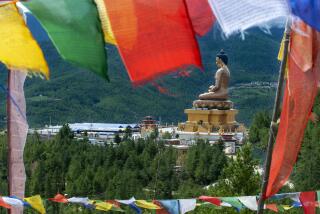Tiny Bhutan in Himalayas Straddles Ages
- Share via
Three decades after opening to the outside world, Bhutan, the tiny Himalayan kingdom in the clouds, has one foot in the Middle Ages and the other in the 21st Century.
Long shielded from the rest of the world by the Himalayas, landlocked Bhutan is wrapped in mountains and wedged between two giants, China and India. About the size of Switzerland, it is a sparsely settled country of about 700,000 people that is scarcely touched by the modern age.
Blue sheep, wild poppies and the elusive snow leopard thrive in this isolation, and some Bhutanese say several varieties of Yeti, the Abominable Snowman, live here too.
Bruce W. Bunting, a vice president of the World Wildlife Fund, walked through a lush oak and rhododendron forest more than 10,000 feet high along a path that a large tiger had trod the night before.
Dogs far outnumber cars on the sleepy streets of Thimphu, the capital city of 30,000 people, Bunting says. Bhutan had little use for gasoline until 1962, when its first highway was finished.
Since opening to the world, this nation, which Bhutanese know as Druk Yul (Land of the Thunder Dragon), has moved toward modernization while holding to traditional Buddhist cultural values.
To reach one of the kingdom’s revered Buddhist sites, Taktshang (Tiger’s Den) Monastery, Bunting climbed to 10,000 feet, accompanied by a monk.
According to ancient scripture, a saint named Guru Rimpoche (Precious Teacher) landed on this mountain from Tibet in the 8th Century astride a flying tiger. The guru later became one of the country’s most important religious figures.
At the monastery, Bunting stood before a statue of Guru Rimpoche. “At that moment it was as if I had been plunged into a world where time ceased to exist,” Bunting says. “The old ways still matter here, even as the country seeks a place in the modern world.”
This often makes for incongruities: A farmer converses in nearly flawless English. A Bhutanese postage stamp depicts Donald Duck. A government minister tunes in an American basketball game on his shortwave radio.
Bhutan’s King Jigme Singye Wangchuck, 35, used to play basketball in his spare time. Today, his task of building a modern nation has been complicated by the politics of southern Bhutan, where activists are demanding reform and violent clashes have erupted between government security forces and demonstrators.
The struggle is between two cultures, the Drukpas of the north and the ethnic Nepalese of the south. In recent years, thousands of Nepalese have resettled as illegal immigrants in southern Bhutan, one reason the royal government recently imposed restrictions on all residents.
The king worries that the nation’s cultural traditions might someday be swamped by the Nepalese living in neighboring Nepal, who outnumber Bhutanese almost 25 to one.
To integrate the Nepalese culture in Bhutan, the government has used financial incentives to encourage marriage between ethnic Nepalese and northerners. To establish Bhutan’s distinct identity, a national dress code has been imposed, requiring all citizens to wear traditional clothing. The government has stopped teaching the Nepali language in schools.
“We want to unify the country as a single entity,” the king said recently. “It is too small to maintain diversity. We want the people living in the south to stop regarding Nepal as their motherland. We are all Bhutanese.”
Bhutan has been slow to take advantage of its natural resources, leaving its extensive forests virtually untouched and most of its rivers running free. To preserve the best of its wild landscape, Bhutan has set aside more than 20% of its land in a system of 10 reserves.
But the kingdom lags behind its neighbors in many ways. It is one of the least-developed nations. Its infant-mortality rate, 128 deaths per thousand, is one of the worst. Its life expectancy, 48 years, is Asia’s second-lowest. Its literacy rate is, at best, about 30%.
Bunting reports, however, that Bhutan’s health-care and educational systems are improving. “This country has one foot in the Middle Ages and the other in the 21st Century,” said the Rev. William Mackey, a Canadian Jesuit teacher who came to Bhutan in 1962. “It’s made remarkable progress.”
Despite signs of change, Bunting writes, “some 90% of Bhutanese live in the cold, clear heights as their forefathers did, following livestock through the high summer meadows, planting plots of rice and chilies in the valleys.”
“Our life is hard but very peaceful,” said a northern woman whose family herds yaks. She sums up the timeless Bhutan that endures despite the country’s growing tensions.
More to Read
Sign up for Essential California
The most important California stories and recommendations in your inbox every morning.
You may occasionally receive promotional content from the Los Angeles Times.













